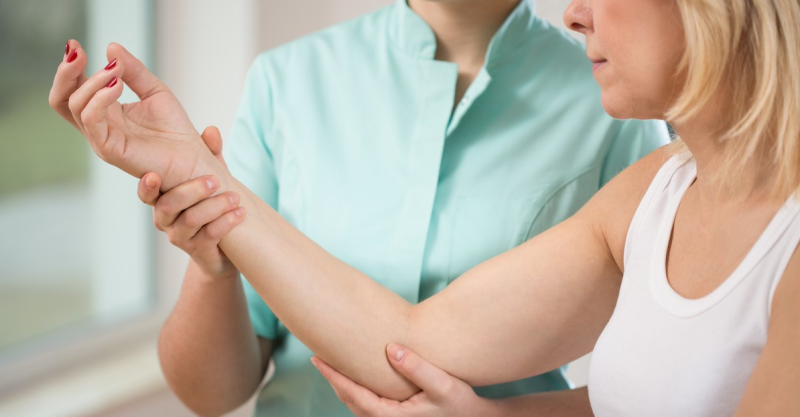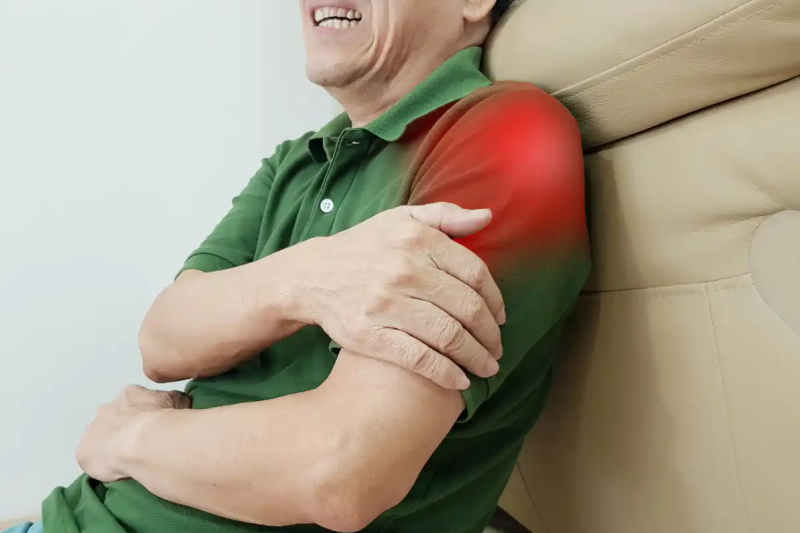
Discomfort in the upper extremities usually causes significant pain when performing daily activities. In general, they result from inflammatory processes due to blows, falls, or repetitive movements of the joints. However, it could also correspond to cardiovascular or neurological problems. We tell you 13 possible causes of pain in the right arm.
This discomfort can be generalized or refer to any point from the shoulder to the hand. In this sense, the pain results from a condition in the muscles, bones, tendons, joints, nerves, blood vessels, or arm skin. Sometimes, they could reveal an injury to another organ, such as a heart attack.
Contents
13 causes of pain in the right arm
Acute cases usually present with intense discomfort for a few days, making proper limb movement difficult. The arm pain can appear abruptly or gradually increase until a maximum intensity. According to studies, chronic ones persist for at least 3 to 6 months.
1. Overexertion
The excessive, continuous, and repetitive use of the upper extremities is a frequent cause of pain. This situation is common in athletes who practice strength sports and in people who carry out tasks involving heavy loads or repetitive movements, such as musicians or machine operators.
Studies affirm that constant effort conditions damage and inflammation of the muscles and joints of the shoulder and arm. In this sense, people may report pain in the right and left arm, fatigue, and muscle weakness.
In most cases, the discomfort subsides after several days of rest. Similarly, professionals can indicate the use of analgesics and anti-inflammatories in acute cases, as well as physiotherapy and rehabilitation for people with chronic pain.
2. Tendonitis
Tendinitis is an inflammatory and irritative process of the tendons, which are bands of tissue responsible for joining the muscles to the bones. Research indicates this condition is expected at the shoulder, elbow, and wrist level due to injury, overload, or improper movement.
It presents with a dull right or left arm ache that worsens with movement or sleep. Similarly, muscle fatigue, tenderness, and swelling of the affected area are common.
The primary therapeutic measure is the relative rest of the limb in association with physiotherapy sessions. Cold compresses and non-steroidal anti-inflammatory drugs (NSAIDs), such as ibuprofen, may help.

3. Bursitis
Bursitis is an inflammatory condition of the bursae, a group of small synovial bags cushion muscles, tendons, and joints. This disorder usually causes pain in the shoulder and elbow of the right arm. Also, any movement or direct pressure on the bursa will cause discomfort, according to studies.
It usually appears after overextending a joint or performing repetitive movements for long periods. Similarly, trauma, as well as arthritis and gout, can cause it.
Treatment is based on administering anti-inflammatory drugs and applying physical means, such as hot or cold compresses, for faster relief of symptoms. In some severe cases, the use of steroids is necessary.
4. Epicondylitis and Epitrochleitis
Epicondylitis and epicondylitis are two common painful disorders at the elbow level. The first, also known as tennis elbow, is an inflammatory process that affects the tendons of the extensor muscles of the hand and wrist that insert into the epicondyle, located on the outer side of the elbow. It is common in tennis and squash players.
Research states that epicondylitis causes shooting pain in the epicondyle area that can radiate to the outside of the arm or forearm. In addition, it is typical for upward extension of the wrist, turning movements of the forearm, and palpation of the area to cause discomfort.
On the other hand, epitrochleitis, also known as golfer’s elbow, is a common disorder in people who perform repetitive elbow flexion. In this case, there is tendonitis of the muscles of the hand and wrist that insert into the epitrochlea, a bony bump located on the inside of the elbow.
In epitrochleitis, the person presents more incredible pain when flexing the wrist and palpating the inflamed area. Treatment includes the use of pain relievers, such as diclofenac, to relieve symptoms and strapping to stabilize the joint.
5. Fracture
Fractures in the right arm can occur at the level of the humerus, radius, or ulna, as well as in the small bones of the hand. It has been shown that they occur due to direct trauma, such as blows, traffic accidents, falls from a height, and repetitive overloading. Similarly, osteoporosis is a predisposing factor in older people.
It usually manifests with severe pain in the affected arm, swelling, redness, bone deformity, and inability to move. In addition, in open fractures, there may be profuse bleeding.
6. Dislocation
A dislocation is the abnormal displacement and misalignment of a joint. The most common causes include injuries from contact sports, falls on an outstretched hand, and traffic accidents.
The dislocated shoulder may be out of place, thrown forward, out, or backward. Similarly, it is common for the joint to be inflamed and cause intense pain and inability to move. On the other hand, some people tend to keep the arm close to the chest and rest the forearm in an anti-algesic position.
The elbow is the second most dislocated joint after the shoulder. The characteristic symptoms are severe pain in the right or left arm, deformity, and loss of joint mobility.
7. Osteoarthritis
Osteoarthritis is one of the most common forms of arthritis worldwide. It is the result of wear and tear of the cartilage that forms the joints, a product of aging. In addition, trauma, obesity, and menopause are trigger factors.
It generally affects joints, knees, and hands more frequently. A publication in Offarm Magazine points out the following symptoms of osteoarthritis:
- Pain when moving the joints that subside with rest.
- Stiffness and limitation of joint movement.
- Crackles when moving the limb.
- Swelling and deformity of the area.
Treatment is based on the use of medications to alleviate the symptoms. In this sense, the therapeutic use of simple analgesics and opioids, NSAIDs, and intra-articular corticosteroids is included.
8. Myocardial infarction
Myocardial infarction is an emergency when blood flow to the heart is partially or entirely blocked. The characteristic symptom is oppressive chest pain that radiates to the left arm. However, although it is less common, the pain can also manifest in the right arm in some people.
Similarly, patients may manifest respiratory distress, profuse sweating, weakness, dizziness, vomiting, and palpitations. The main risk factors for heart attack include obesity, high blood pressure, smoking, high cholesterol, and aging.
If you suspect a heart attack, you must go immediately to the hospital emergency service. Health professionals are the only ones trained to diagnose this entity and provide the most appropriate treatment to alleviate symptoms.
9. Carpal tunnel syndrome
It is a neurological disorder resulting from compression of the mediated nerve that extends from the arm to the hand, inside the carpal tunnel. The disease is common in people who perform repetitive wrist movements, such as secretaries, writers, sewists, and musicians.
Nerve compression causes shooting pain in the hand and wrist that radiates down the right arm. In addition, there is often numbness and tingling, muscle weakness, and difficulty holding objects. According to experts, other causes include wrist injuries, neuropathies, rheumatoid arthritis, acromegaly, and pregnancy.
The therapeutic plan is based on using splints when sleeping and the application of cold or hot compresses in the area. Similarly, it may be necessary to use anti-inflammatories, corticosteroid injections, and the administration of neuromodulatory drugs.

10. Brachial plexus injury
The brachial plexus is a network of nerves located at the cervical level responsible for sending electrical impulses from the spinal cord to the shoulders, arms, and hands—compression, stretching, and trauma at this level cause neurological symptoms in the right or left arm.
In minor injuries, the sensation of electric shocks in the arm is familiar, as well as numbness and weakness of the extremity and, in severe cases, numbness, paralysis, and severe pain in the right arm.
A study carried out in 2014 indicates an estimated incidence of 90% of cases related to motorcycle accidents. It generally occurs in young and labor-active people, frequently associated with traffic accidents. Other causes are contact sports and fall.
Treatment depends on the injury’s severity, including physical therapy, splinting, and reconstructive surgery. In the latter case, the ideal time for the surgical approach is in the first six months.
11. Herniated disc
According to research, a herniated disc results from protrusion or displacement of the nucleus pulposus contained in the intervertebral discs of the spine. Cervical hernias can compress nerve roots and cause severe pain in the back and arms, tingling, numbness, and muscle weakness.
Conservative treatment is based on lifestyle modifications to prevent pain, plus anti-inflammatory drugs, steroids, muscle relaxants, and opioids. Similarly, the doctor may recommend physiotherapy sessions and surgery to repair the defect.
12. gout
It is a type of arthritis characterized by hyperuricemia and uric acid deposit in the joints, whose prevalence in developing countries is 1 to 2%. It usually manifests with severe pain and swelling in the elbows, wrists, knees, ankles, and feet.